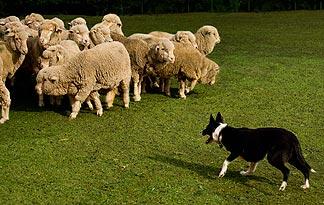Nick Koudis/Getty Images
For dogs, being mankind's best friend may be their happiest job, but one of the most traditional canine careers is that of herding. The herding dog, also known as the stock or cattle dog, was developed to help control and direct herds of cows or sheep out to pasture or back to the barn. These dogs have a natural ability to control the movement of other, larger animals, whether by nipping at them, barking or circling around them. Their special talent, high energy and work ethic make them a shepherd or farmer's invaluable ally in letting livestock know who's the boss.
The American Kennel Club (AKC) currently recognizes 25 breeds in its Herding Group designation, which was created in 1983. Varying in size, appearance and country of origin, and ranging from the Australian cattle dog to the Swedish Vallhund, these breeds all share the trait of being able to successfully shepherd other critters, much larger than or very different from themselves.
Herding breeds are born with an instinctive tendency to herd. But because most contemporary herding dogs live as companion animals, not workers, they may never come in contact with a flock of sheep or cattle to be driven. Your own herding dog's impulse to "round-up" might pop up when he nudges you toward the feeding dish or pushes the cats away from his favorite napping spot. A little training will cultivate his natural ability. In fact, even if your dog is not one of the herding breeds, he may still have the agility and intelligence to be trained to herd.
You can begin by teaching your dog to stay when you throw a favorite toy, then to chase it on command. He'll need an introduction to livestock, so a visit to a farm or ranch where he can observe sheep or cows in pens is a good first step - and you'll see how your dog reacts when he's around them. The AKC offers an instinct test for members of the Herding Group and other breeds, which helps gauge the dog's ability and trainability. You can request a copy of the group's rules and regulations that will spell out what's required of a herding dog. With the help of a trainer or online classes, you can work toward those tasks with your dog, even if he isn't an official Herding Group member.
You can also enter your dog in herding trials. These events simulate the traditional tasks of the herding breeds' heritage, moving and fetching livestock, and allow your dog enjoy the sport of his inborn skills. Your dog will revel in running alongside livestock, guiding them with sharp barks, maybe a nip or two, and encouraging them to move as a group to their destination.
So, if you bring home a corgi or a collie, will you need a flock of sheep to keep Lassie busy and happy? That depends. According to Border Collie Rescue Inc., this particular breed's herding instinct is so deep, and its working style so specific - driving a herd toward the handler rather than away from him - that it will try to round up playing children with excessive zeal, making border collies the wrong choice for most families.
Other herding breeds whose drive is not as intense may be inclined to gently herd toddlers or the mailman, but can be taught not to do so. A herding dog without a herd may not be destructive or unhappy, but he's still a high-energy pet who thrives on exercise, activity and stimulation.
FOR MORE ON THIS AND OTHER DOG INFO FOLLOW THE LINK TO THE SOURCE OF THIS BLOG......http://www.animalplanet.com/pets/do-dogs-automatically-know-how-to-herd/

No comments:
Post a Comment